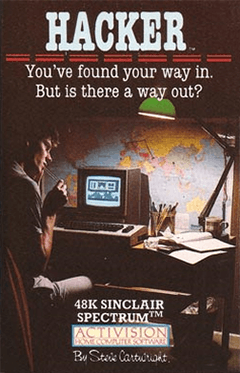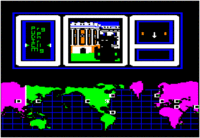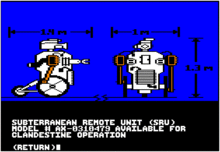Hacker (video game)
| Hacker | |
|---|---|
 ZX Spectrum cover art for Hacker | |
| Developer(s) | Activision |
| Publisher(s) | Activision |
| Producer(s) | Brad Fregger |
| Designer(s) | Steve Cartwright |
| Engine | Custom |
| Platform(s) | Amiga, Amstrad CPC, Apple II, Atari XL/XE, Atari ST, Commodore 64, PC (MS-DOS), Macintosh, MSX, ZX Spectrum |
| Release date(s) | 1985, 1986, 1988 |
| Genre(s) | Puzzle/Strategy |
| Mode(s) | Single player |
| Distribution | Cassette, 3½" or 5¼" disk |
Hacker is a 1985 computer game by Activision. It was designed by Steve Cartwright, produced by Brad Fregger and was released for the Amiga, Amstrad CPC, Apple II, Atari XL/XE, Atari ST, Commodore 64, Macintosh, MS-DOS, MSX and ZX Spectrum. The game was released two years after the release of the film WarGames, when computer hacking and computer security were in the limelight.
Description
Activision executive Jim Levy introduced Hacker to reporters by pretending that something had gone wrong during his attempt to connect on line to company headquarters to demonstrate a new game. After several attempts he logged into a mysterious non-Activision computer, before explaining "That, ladies and gentlemen, is the game". The player assumes the role of a hacker, a person experienced in breaking into secure computer systems, who accidentally acquires access to a non-public system. The game was shipped with no information on how to play, thus building the concept that the player did hack into a system.[1]
The player must attempt to hack into the Magma Ltd. computer system at the beginning of the game by guessing the logon password. Access can be gained if the player knows the password, which really only ever becomes apparent to the player after gaining access, through another means of entry, to the later stage of the game. Typing help or h in the command line would give a clue as to what the valid password is. Since initial attempts at entry would consist of guessing (and likely failing) access would eventually be granted to the player due a malfunction in the security system. Once admittance has been made, the player is then asked to identify various parts of a robot unit, by pointing the cursor at the relevant parts and pressing the fire button. Most parts of the unit have exotic and technical names, such as "asynchronous data compactor" or "phlamson joint"—this again allows more room for error by initially trying to guess which part each name belongs to. Failure to identify each part correctly forces the player to take a retest until a 100 percent identification is made, at which point the player is then allowed to continue.
The player gains control of the robot which can travel around the globe via secret tunnels, deep within the earth. The game's text states that the robot is powered in some manner by magma.
Before getting far, the player is informed that shredded portions of a secret document containing Magma Ltd.'s plans for world domination have been stolen. The player is instructed to retrieve the document by bargaining with the spies who stole it, who are located at various locations throughout the globe. The player is warned that it must be retrieved in order to prevent the US government from thwarting their plans. At this point, the player's objective is clear: retrieve the strips of the stolen document, then deliver them to Washington DC.
The robot's tunnel system is extensive but unmarked, so getting around is initially an exercise in trial and error. Throughout the globe, there are several cities where the robot can surface and interact with people, primarily the spies who want to bargain for their piece of the evidence.

At the various surfacing cities, the player must try to convince the agents to turn over their piece of evidence. Initially the player only has $5,000 to bargain with, but his arsenal of items grows over time and bargaining. The real challenge of the game is determining what each spy wants and how to get it for them. Eventually, all the spies' whims can be satisfied for all the pieces of the secret document. Note that different copies of the game, even on the same computer platform, have differences in which items the spies want.
If this isn't enough, however, Magma Ltd. discovers the player's break-in shortly after penetration. It launches a security satellite which, when it intersects with the player's position, questions him for information which supposedly only a legitimate user would know. The information queried was given to the player previously in the game, but the questions can only be answered if the player has taken careful notes as some of the information asked for is rather obscure.
Since the game lacks a save game feature, a player who fails must start again from the beginning to try to solve the game's puzzles.
Reception
By late 1987 more than 50,000 copies of Hacker were sold, and it was Activision's third best-selling Commodore game.[2] Compute! praised Hacker 's initial realism, and concluded that it was "a worthy addition to your software collection, especially if you enjoy adventure games that require a bit of thought and an investment of time".[3] Ahoy! wrote that the game's puzzle nature "is certain to enthrall some and repel others ... repeated play is an integral part of reaching the solution. Those who enjoy a protracted battle of wits will find Hacker a lively test of their abilities".[4]
Legacy
This game was followed in 1986 by the much more difficult Hacker II: The Doomsday Papers. In the sequel, the player is actually recruited based upon his (assumed) success with the activities in the original game. Once again, they are tasked with controlling a robot, this time to infiltrate a secure facility in order to retrieve documents known only as "The Doomsday Papers" from a well-guarded vault to ensure the security of the United States.
See also
- System 15000
- Neuromancer
- System Shock
- Uplink
References
- ↑ Bateman, Selby; Yakal, Kathy (October 1985). "The New Games". Compute!. p. 32. Retrieved 16 October 2013.
- ↑ Ferrell, Keith (December 1987). "The Commodore Games That Live On And On". Compute's Gazette. pp. 18–22. Retrieved 24 January 2015.
- ↑ Heimarck, Todd (April 1986). "Hacker". Compute!. p. 65. Retrieved 8 November 2013.
- ↑ Davidson, Steve (January 1986). "Hacker". Ahoy!. p. 54. Retrieved 2 July 2014.
External links
- Hacker at MobyGames
- Hacker at World of Spectrum
- Hacker can be played for free in the browser at the Internet Archive
